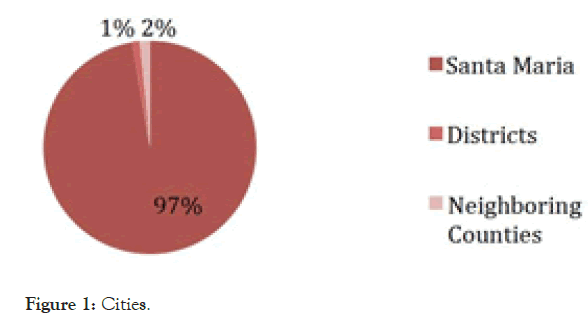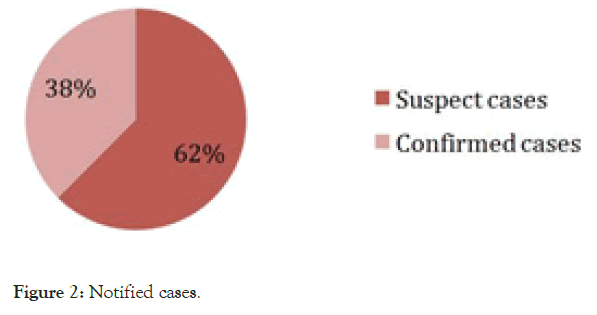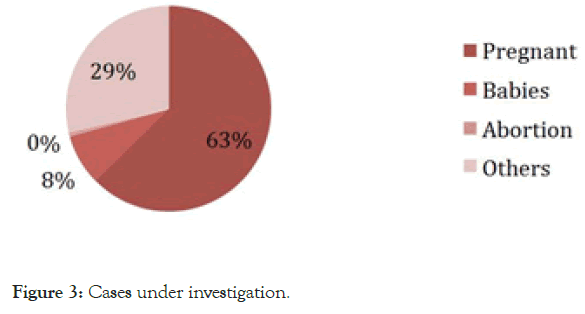Journal of Infectious Diseases & Preventive Medicine
Open Access
ISSN: 2329-8731
ISSN: 2329-8731
Research Article - (2019)Volume 7, Issue 2
Introduction: In the first months of 2018, there was an increase in the number of cases of fever possibly related to Toxoplasmosis in the city of Santa Maria, Brazil, reaching significant values. Toxoplasmosis is an autoimmune acute infection usually asymptomatic in 80-90% of immunocompetent adults. In this outbreak, attention is drawn to the intensity of the symptoms presented, which were observed in more than 70% of the cases.
Objective: To report the cases of the outbreak of toxoplasmosis in the city of Santa Maria, Brazil.
Methods: Cross-sectional study. Data were collected from bulletins published by the Municipal Health Department of Santa Maria, Rio Grande do Sul, Brazil.
Results: The outbreak of toxoplasmosis in Santa Maria was confirmed on April 19, 2018. Until June 14, 2018, 510 cases were confirmed. According to the most recent bulletin released by the State Health Department on June 8, 2018, 441 occurrences are people residing in Santa Maria, five are residents of the districts and seven cases are patients residing in neighboring counties. In a bulletin published on May 25, 2018, 1,116 cases were reported to state epidemiological surveillance by the end of May. Of these, 766 cases were still suspected (fever, headache and/or myalgia accompanied by lymphadenopathy, weakness, arthralgia or change in vision. In the other 460 cases, there was laboratory confirmation for acute toxoplasmosis, of which 35 were pregnant, with two fetal deaths (36 and 28 weeks) and two abortions. There are also 212 cases still pending laboratory confirmation, of which 133 were pregnant women, 1 was a spontaneously aborted fetus and 17 were children. Tests carried out on the water supplying the city so far have resulted negative for toxoplasmosis.
Conclusion: The results of this research show that the current outbreak of toxoplasmosis in the city of Santa Maria, Brazil, is the largest reported in the world.
Toxoplasmosis; Santa Maria; Immunocompetent adults; Myalgia; Occipital lymphadenopathy
In January, 2018, there was an increase in the number of cases of fever possibly related to Toxoplasmosis in the city of Santa Maria, Brazil, reaching significant values. This increase was observed by the doctors of the city. Santa Maria is a medium size city, located in a central area of the southernmost state in Brazil, Rio Grande do Sul.
Toxoplasmosis is a zoonotic infection that is highly prevalent throughout the world. It is caused by Toxoplasma gondii, an intracellular coccidian parasite that infects several animal species. Human infection occurs after ingestion of cysts from undercooked and contaminated meat. Alternatively, humans may ingest oocysts from contaminated water, soil and vegetables [1]. Toxoplasmosis is acute infection, usually asymptomatic in 80%-90% of immunocompetent adults [2]. While most affected individuals are not symptomatic, some may develop flu-like symptoms, especially people whose immune systems are less effective than normal. These symptoms can include fever, swollen lymph nodes, especially in the neck, headache, muscle aches and sore throat [3]. The most common symptom is neck or occipital lymphadenopathy. Serology is the diagnostic gold standard in immunocompetent individuals.
The presence of IgM antibodies is, however, not sufficient to make a definite diagnosis of acute toxoplasmosis. Distinction between acute and chronic toxoplasmosis requires additional serological tests (IgG avidity test). If required, the most used and probably most effective treatment is the combination of pyrimethamine and sulfadiazine, with folic acid [4].
Other outbreaks have already been described. A systematic review from 2015 of toxoplasmosis outbreaks reported in 1966 and 2009 in 38 papers, with 71% (27/38) of the cases in the Americas, showed that the source of water contamination was present in 21% of the reports. Water contamination by cysts was described mainly in Brazil and Canada [5-7]. An outbreak of toxoplasmosis between 2004 and 2005 has been described in India. It is believed that the source of contamination was by water and that more than 25% of people suffered ophthalmological complications [8,9].
In this outbreak, attention is drawn to the intensity of the symptoms presented, which were observed in more than 70% of the cases, including fever for 10-14 days, myalgias, painful cervical and occipital lymphadenopathy, fatigue, lack of appetite with interference with daily activities which persisted for up to 4 to 6 weeks [10].
The aim of this study is report the outbreak of toxoplasmosis in the city of Santa Maria, Brazil.
This is a retrospective, cross-sectional study on the outbreak of toxoplasmosis in Santa Maria, Rio Grande do Sul, Brazil. Data was collected from the bulletins of the Municipal Health Department of Santa Maria, Rio Grande do Sul, Brazil, between April 2018 to June 2018. These bulletins were publicly available data published on the internet about the outbreak. In June, 2018, the writing of this article has been finalized.
Since the data was publicly available and already de-identified, no consent was required for this study.
The outbreak of toxoplasmosis in Santa Maria was confirmed on April 19, 2018. By June 14, 2018, 510 cases were confirmed. According to the most recent bulletin until the end of this study, released by the State Health Department on June 8, 2018, 441 occurrences are people residing in Santa Maria; they are 97% of total cases. Five people are residents of the districts of Santa Maria, and 7 cases are patients residing in neighboring counties, near to Santa Maria (Figure 1).

Figure 1. Cities.
According to a bulletin published on May 25, 2018, 1,116 cases were notified to state epidemiological surveillance. Of these, 766 cases were still suspected until the end of this study, and these patients were performing with fever, headache and/or myalgia accompanied by lymphadenopathy, weakness, arthralgia or change in vision. In the other 460 cases, there was laboratory confirmation for acute toxoplasmosis, of which 35 were pregnant, with two fetal deaths (36 and 28 weeks) and two abortions miscarriage (Figure 2).

Figure 2. Notified cases.
There are also 212 cases still pending laboratory confirmation, of which 133 were pregnant women, 1 was a spontaneously aborted fetus (miscarriage) and 17 are babies (Figure 3). Tests carried out on the water supplying the city so far have turned negative for toxoplasmosis.

Figure 3. Cases under investigation.
The results of this research show that the current outbreak of toxoplasmosis in the city of Santa Maria, Brazil, is the largest reported, not just in Brazil, but is the largest in the world. Even the most likely cause of transmission is contaminated water, after months since the first case of toxoplasmosis of this outbreak, definitive results of tests are pending to show that the cause of this outbreak was the water contamination.
Citation: Arquilla B, Bloem C, Burguêz D, Andrioli G, Ponte STD (2019) Outbreak of Toxoplasmosis in the City of Santa Maria, Brazil. Journal of Infectious Diseases and Preventive Medicine. 7:191. DOI: 10.35248/2329-8731.19.07.191.
Received: 04-Nov-2019 Accepted: 18-Nov-2019 Published: 25-Nov-2019 , DOI: 10.35248/2329-8731.19.7.191
Copyright: © 2019 Arquilla B, et al. This is an open-access article distributed under the terms of the Creative Commons Attribution License, which
permits unrestricted use, distribution, and reproduction in any medium, provided the original author and source are credited.